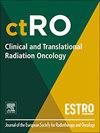PSMA response evaluation in follow-up PSMA-PET/CT after stereotactic ablative body radiotherapy (SABR) for oligometastases in prostate cancer
IF 2.7
3区 医学
Q3 ONCOLOGY
引用次数: 0
Abstract
Purpose
PSMA-PET/CT is frequently used for staging patients with de-novo or recurrent prostate cancer (PCa). In patients with oligometastatic PCa PSMA-PET/CT guided stereotactic ablative body radiotherapy (SABR) is a common treatment option. Follow-up is regularly performed via measurement of prostate-specific-antigen (PSA) level. Response assessment based on follow-up PSMA-PET/CTs is poorly studied. Therefore, we report on long-term local tumor response using repeated PSMA-PET/CTs of patients with oligometastatic PCa after PSMA-PET/CT guided SABR.
Methods/Patients
Patients with de-novo oligometastatic or oligoprogressive PCa who received PSMA-PET/CT-directed SABR with 5 × 7 Gy of at least one bone or lymph node lesion between 2015 and 2019 and had one or more follow-up PSMA-PET/CT were included in this retrospective single center analysis. PSMA response was evaluated by visual and quantitative assessment of local PSMA uptake pre- and post-SABR.
Results
Overall, 48 patients with 97 irradiated lesions and a total of 145 PSMA-PET/CT-scans were analyzed. 26 patients received androgen-deprivation-therapy (ADT) at any time. Median SUVmax per lesion was 10.88 (range 1.59–122.11) before SABR with a median CTV of 4.75 cm3 (Range 0.68–60.4 cm3). In the first follow-up PET/CT after a median of 13 months (range 3–42) after SABR, median SUVmax per lesion declined to 2.2 (range 0.13–26.09). Complete remission (CR) was observed in 49 lesions, partial remission in 32 and stable disease in 12 lesions. Four lesions were non-responders. Over the course of up to five follow-up PSMA-PET/CTs a maximum of 90 % of the lesions showed CR. Median time to SUVmin was 19 months (range 3–50). 5-year local control was 86 %. No short-term or long-term toxicities were reported.
Conclusion
PSMA-PET/CT directed SABR provides excellent long-term local tumor control of 90% in bone and lymph node metastasis of oligometastatic PCa and is well tolerated. PSMA activity may further decrease after initial re-imaging with PSMA-PET/CT.
立体定向消融体放疗(SABR)治疗前列腺癌寡转移灶后随访PSMA pet /CT反应评价
目的:sepsma - pet /CT常用于前列腺癌复发患者的分期。在少转移性前列腺癌患者中,PSMA-PET/CT引导立体定向消融体放疗(SABR)是一种常见的治疗选择。定期随访,检测前列腺特异性抗原(PSA)水平。基于PSMA-PET/ ct随访的疗效评估研究甚少。因此,我们报告了在PSMA-PET/CT引导的SABR后,使用重复PSMA-PET/CT对低转移性PCa患者的长期局部肿瘤反应。2015年至2019年期间接受PSMA-PET/CT定向SABR (5 × 7 Gy,至少有一个骨或淋巴结病变)并进行一次或多次PSMA-PET/CT随访的低转移性或低进展性PCa患者纳入本回顾性单中心分析。通过sabr前后局部PSMA摄取的视觉和定量评估来评估PSMA的反应。结果共分析了48例患者的97个放射病灶和145个PSMA-PET/ ct扫描。26例患者在任何时间接受雄激素剥夺治疗(ADT)。SABR前每个病灶的中位SUVmax为10.88(范围1.59-122.11),中位CTV为4.75 cm3(范围0.68-60.4 cm3)。在SABR后的第一次随访PET/CT中位数为13个月(范围3-42),每个病变的中位SUVmax下降到2.2(范围0.13-26.09)。49例完全缓解,32例部分缓解,12例病情稳定。4个病灶无反应。在长达5次的PSMA-PET/ ct随访过程中,最多90%的病变显示CR,中位SUVmin时间为19个月(范围3-50)。5年局部控制率为86%。无短期或长期毒性报告。结论psma - pet /CT定向SABR对低转移性前列腺癌的骨和淋巴结转移具有良好的长期局部肿瘤控制性,可达90%,且耐受性良好。PSMA活性在PSMA- pet /CT首次重新成像后可能进一步降低。
本文章由计算机程序翻译,如有差异,请以英文原文为准。
求助全文
约1分钟内获得全文
求助全文
来源期刊

Clinical and Translational Radiation Oncology
Medicine-Radiology, Nuclear Medicine and Imaging
CiteScore
5.30
自引率
3.20%
发文量
114
审稿时长
40 days
 求助内容:
求助内容: 应助结果提醒方式:
应助结果提醒方式:


